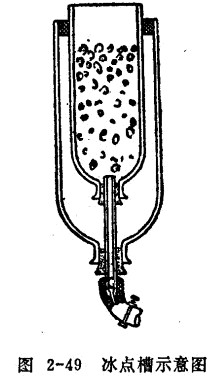The calibration of mercury thermometers and pressure thermometers is carried out by comparison method. Various thermostatic baths used as calibration equipment include low temperature baths, ice point baths, water baths, oil baths and salt baths. Different thermostatic baths have different usage ranges.
Thermometers with a zero-point scale line must be calibrated to zero point. The constant temperature bath for zero point calibration is an ice point bath. The structure of the ice point bath is shown in Figure 2-49. The bath is filled with a mixture of pure fine ice and pure water, and the water surface is slightly lower than the ice surface. The mixing ratio of ice and water should be moderate, "generally about three to one. Excess water can be discharged from the bottom of the container. The ice in the container should be shaved into fine powder and mixed evenly with water. There should be no bubbles in the mixture. A stable 0℃ is formed in the ice-water mixture to calibrate the zero point of the thermometer.
The structure of the water tank is shown in the figure below. The inner cylinder 1 is filled with water, and the water is heated by the electric heating wire 8. Adjusting the sliding point of the self-heating transformer 5 can change the heating current. When the stable working condition is reached, the temperature in the tank is constant. The water is continuously stirred by the stirrer 3 in the inner cylinder, so that there is a uniform temperature field area in the cylindrical cylinder 6. During calibration, the standard thermometer and the calibrated thermometer are inserted into this area at the same time to compare the readings.
The structure of the oil tank is the same as that of the water tip, but the cylinder is filled with oil. Light oil can be used when working in a lower temperature range, and heavy oil can be used in a higher temperature range.

The structure of the low-temperature trough is similar to that of the water trough. Generally, a mixture of 55% potassium nitrate and 45% sodium nitrate is used as the working liquid. The melting temperature of this salt is about 218℃, and the upper temperature can reach about 550℃. Pay special attention to safety when using salt to prevent explosion.
The structure of the low-temperature trough is similar to that of the water trough. Alcohol or isopentane can be used as the cooling medium. The minimum working temperature varies with the cooling medium. The most commonly used cooling media are dry ice, liquid nitrogen, etc.
By comparing the readings of the standard thermometer and the calibrated thermometer inserted in the constant temperature trough at the same time, the error of the calibrated thermometer can be determined.

















